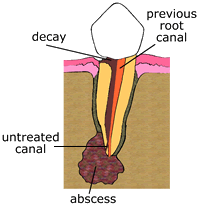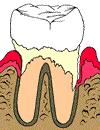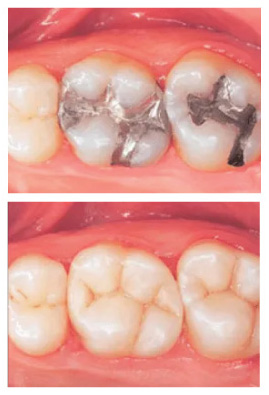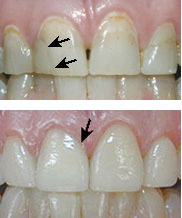Root Amputation
Root amputation refers to the removal of one root in a multi-rooted tooth.
These procedures may become options for treatment when there is a persistent endodontic failure in ONLY one root of a “key tooth” which must be kept, or if there is significant bone loss around an individual root due to periodontal (gum) disease. With the advent of modern dental implants, hemisection and root amputation are often done as a “temporary measure” to allow enough bone healing, so an implant can be placed at a later date.
Show allRoot amputation refers to the removal of one root in a multi-rooted tooth.
These procedures may become options for treatment when there is a persistent endodontic failure in ONLY one root of a “key tooth” which must be kept, or if there is significant bone loss around an individual root due to periodontal (gum) disease. With the advent of modern dental implants, hemisection and root amputation are often done as a “temporary measure” to allow enough bone healing, so an implant can be placed at a later date.
Show less
Root Canal Retreatment
Retreatment is necessary when bacteria have re-entered the tooth. This is usually due to decay or untreated canal areas. The patient may experience swelling or pain in chewing.
Show allRetreatment is necessary when bacteria have re-entered the tooth. This is usually due to decay or untreated canal areas. The patient may experience swelling or pain in chewing.
Sometimes a patient may have no symptoms, but an x-ray shows that there is a problem with a tooth that has previously undergone root canal therapy.
What Happens During Root Canal Retreatment?

Step one:

Step two:

Step three:

Root Canal Therapy
When the nerve of a tooth becomes infected or abscessed, Root Canal Therapy is the only way to save the tooth. A tooth can become abscessed as a result of deep decay, a cracked tooth, or trauma to the tooth. The only alternative to Root Canal Therapy is an Extraction.
Show allWhen the nerve of a tooth becomes infected or abscessed, Root Canal Therapy is the only way to save the tooth. A tooth can become abscessed as a result of deep decay, a cracked tooth, or trauma to the tooth. The only alternative to Root Canal Therapy is an Extraction.
During Root Canal Therapy, the tooth is “numbed” (just like having a filling). Then the unhealthy nerve is removed and medication is placed in the tooth to treat the bacterial abscess (infection). After the infection is removed and treated, a filling is placed in the roots where the unhealthy nerve was.
A tooth that has undergone Root Canal Therapy is more brittle and must be crowned to give the tooth sufficient strength. The tooth is cared for in the same way as other natural teeth. Brush and floss daily, and visit your dentist for regular preventative dental check-ups.
High-Tech Root Canal Therapy

The way root canal therapy is performed today is vastly different than those done a few years ago, not to mention a decade ago. The potential level for quality care has dramatically increased. It is a thing of the past to do root canals in five to six appointments, or by “touch or feel” because we could not see. Root canals can be done painlessly, faster, and more accurately due to the new technology available.
Non-surgical Root Canal Therapy

Root Canal Therapy is a dental procedure, performed with local anaesthetic, which involves the removal of the nerve inside of the tooth because it has become irreversibly damaged or infected. This is usually due to the entry of bacteria into the centermost part of the tooth called the dental pulp (nerve). ROOT CANAL is a commonly used term for endodontic therapy or root canal therapy. This procedure involves the removal of the entire nerve system, as well as cleaning, shaping and 3-dimensional filling of the canal system with gutta percha and a dental sealer. The procedure enables you to keep your natural tooth, which is preferable to any type of replacement.
What Happens During Root Canal Therapy?

Step one:

Step two:

Step three:

Root Planing
Scaling and Root Planing is a common non-surgical treatment for periodontal disease. By using special instruments, we remove bacteria and infection from the unhealthy deep pockets around the teeth below the gum line. This is often referred to as a “deep cleaning”.
Show allScaling and Root Planing is a common non-surgical treatment for periodontal disease. By using special instruments, we remove bacteria and infection from the unhealthy deep pockets around the teeth below the gum line. This is often referred to as a “deep cleaning”.
 First the tooth is scaled to remove the plaque and tarter that has accumulated on the tooth.
First the tooth is scaled to remove the plaque and tarter that has accumulated on the tooth.
 Then the root is planed or smoothed. This eliminates any rough areas on the root that can easily trap plaque and bacteria.
Then the root is planed or smoothed. This eliminates any rough areas on the root that can easily trap plaque and bacteria.
 A smooth clean root provides a healthy environment to allow the gums to heal naturally and reattach to the tooth. This will create a reduced pocket, therefore eliminating areas for bacteria to hide and cause further disease.
A smooth clean root provides a healthy environment to allow the gums to heal naturally and reattach to the tooth. This will create a reduced pocket, therefore eliminating areas for bacteria to hide and cause further disease.
Scaling and Root Planing combined with a strict home care routine and more frequent periodontal cleanings and exams will increase your chances of keeping your natural smile.
Advanced Medications
Recent advances in periodontal treatment allow us to now place Tetracycline Gel directly at the site of infection. This is often used in conjuction with scaling and root planing. In addition, an antimicrobial rinse is sometimes used after some procedures.
Oral Medications

A new medication called Periostat® has been developed specifically to combat periodontal infection by bolstering your body’s immune response to bacteria that cause periodontal disease. Dr. Loar will evaluate your specific case to see if Periostat® is right for you.
Strict Home Care Regimen
A home care routine specific to the patient’s individual needs may be prepared to prevent the patient from relapsing.
Show less

White Fillings
After decay is removed from a tooth, something must be placed in that space to give strength back to the tooth.
Show allAfter decay is removed from a tooth, something must be placed in that space to give strength back to the tooth.
Fillings: Fillings are the most common restorative procedure.
Inlays and onlays: In addition to fillings, lab fabricated inlays and onlays are sometimes used. Although many patients think of these as fillings as well, they are actually different since they are laboratory fabricated.

White fillings: White fillings are used almost all of the time in our office. They are an attractive, durable alternative to silver (amalgam) fillings. White fillings are made of a strong composite resin that is matched to the surrounding tooth color. In the past, white fillings were placed only on front teeth, but recently a stronger more durable material has been developed that can withstand the chewing pressure of back teeth.

Silver (amalgam) fillings: Although white composite resin fillings are used almost exclusively by our office, there may be unique circumstances that call for a silver (amalgam) filling. Typically, silver fillings are placed on back teeth (molars).

White Porcelain or Resin inlay or onlay: A porcelain or resin inlay or onlay is used when the cavity is too big for a filling, but isn’t so big that a crown is required. An inlay is a filling within the cusp tips of the tooth. Onlays (also known as overlays) will overlay one or more cusps in order to protect and strengthen the tooth.

An inlay or onlay may also be made of gold.
Show less

Crowns
A crown fits over the entire top of the tooth above the gum line. Crowns cover, protect, seal and strenthen a tooth. A crown is needed when a filling just will not work. A crown may be made of gold, white porcelain, or procelain fused to gold. There are many situations that may call for a crown.
Show allA crown fits over the entire top of the tooth above the gum line. Crowns cover, protect, seal and strenthen a tooth. A crown is needed when a filling just will not work. A crown may be made of gold, white porcelain, or procelain fused to gold. There are many situations that may call for a crown.
- Large decay. If a tooth has decay so deep and large that a filling will not stay, or if the tooth structure is weakened, a crown must be placed on the tooth to save it.
- Large old fillings. When large old fillings break down, or get decay around them, they usually need to be crowned. It is important to crown a tooth tthat has been structurally weakened to prevent a cracked or broken tooth. Once a tooth breaks, it may not be possible to save it.
- Cracked tooth. When a tooth is cracked, a filling will not seal the crack. A crown has to be placed over the tooth to hold it and the crack together. If a crown is not placed on the tooth, the tooth will become sensitive to chewing pressure, or will eventually break. It is important to crown a cracked tooth before it breaks, because in some cases a broken tooth cannot be crowned and must be extracted.
- Broken / Fractured tooth. A tooth that has broken is usually too weak to hold a filling. A crown will hold the tooth togethr and prevent it from breaking again. If the fracture involves the nerve, Root Canal Theramy may be required before the tooth is croned. In some cases, a broken tooth cannot be saved and must be extracted.
- Sensitive teeth. Teeth that are very sensitive, either from a lot of “wear”, or from receded gums, sometimes require crowns to seal and protect the theeth from hot and cold sensitivity.
- Root Canal Therapy. A tooth that has undergone Root Canal Therapy will need a crown to properly seal and protect the tooth. A tooth with Root Canal Therapy is more brittle than a tooth with a healthy nerve and blood supply. A crown provides the necessary support to the tooth.
- In cosmetic dentistry, crowns (sometimes called “caps) are used less frequently since the advent of veneers, but in some cases a crown may be necessary for a particular tooth. A tooth with a bad fracture or a large filling may be a candidate for a crown instead of a veneer.
Before: This tooth has a large filling as shown. A crown is needed on this tooth, instead of a veneer, because there isn’t enough natural tooth left to support a veneer. A crown will cover and protect the tooth, but will look the same as a veneer.
After: The top teeth now have veneers, except the one that had the large filling, which now has a crown.
Show less


